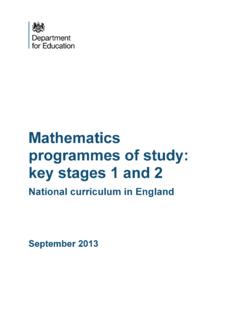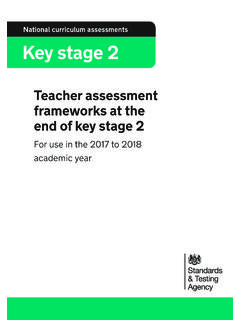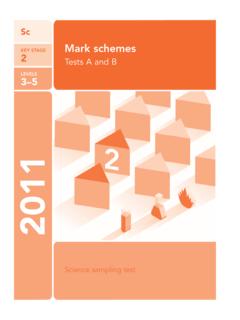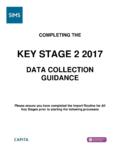Transcription of Final Report from the Primary Phase: Pre-school, …
1 Contents Effective Pre-school and Primary Education 3-11 Project (EPPE 3-11) Final Report from the Primary Phase: Pre-school, School and Family Influences on Children s Development During key stage 2 (Age 7-11) Kathy Sylva+, Edward Melhuish#, Pam Sammons$, Iram Siraj-Blatchford* and Brenda Taggart* +University of Oxford, #Birkbeck, University of London, $University of Nottingham and *Institute of Education, University of London The views expressed in this Report are the authors and do not necessarily reflect those of the Department for Children, Schools and Families. Sylva, Melhuish, Sammons , Siraj-Blatchford & Taggart 2008 ISBN 978 1 84775 292 5 Research Report No DCSF-RR061 Contents Contents THE EPPE 3-11 RESEARCH TEAM Principal Investigators Professor Kathy Sylva Department of Education, University of Oxford 00 44 (0)1865 274 008 / email Professor Edward Melhuish Institute for the Study of Children, Families and Social Issues Birkbeck University of London 00 44 (0)207 079 0834 / email Professor Pam Sammons School of Education, University of Nottingham 00 44 (0)115 951 4434 / email Professor Iram Siraj-Blatchford Institute of Education, University of London 00 44 (0)207 612 6218 / email *Brenda Taggart Institute of Education, University of London 00 44 (0)207 612 6219 / email Research Officers Dr Sofka Barreau Institute of Education, University of London 00 44 (0)
2 207 612 6608 / email Dr Yvonne Anders (n e Grabbe) Institute of Education, University of London 00 44 (0)207 612 6608 / email Dr Stephen Hunt Institute of Education, University of London 00 44 (0)207 612 6608 / email Dr Helena Jelicic Institute of Education, University of London 00 44 (0)207 612 6608 / email Rebecca Smees Institute of Education, University of London 00 44 (0)207 612 6608 / email Wesley Welcomme Institute of Education, University of London 00 44 (0)207 612 6684 / email Olga Cara Institute of Education, University of London 00 44 (0)207 612 6608 / email Contents *Also Research Co-ordinator ACKNOWLEDGEMENT The EPPE 3-11 project is a major longitudinal study funded by the Department for Children, Schools and Families (DCSF). The research would not be possible without the support and co-operation of the six Local Authorities (LAs) and the many pre-school centres, Primary schools, children and parents participating in the research.
3 EPPE is an associate project in the ESRC Teaching and Learning Research Programme. Contents Contents Page no. Executive Summary i Section 1: Introduction and background to the study 1 Summary of Key Messages 1 Earlier findings from the EPPE research programme: ages 3 - 7 1 The impact of pre-school at school entry (age 5) 2 The impact of pre-school at the end of Key stage 1 (age 7) 3 What differentiates the most effective pre-schools?: Evidence from case studies 4 Section 2: How EPPE 3-11 studied children s development 8 Summary of Key Messages 8 Design of the study 8 Aims of the research for key stage 2 (KS2) 8 The Sample 8 Child trajectories 9 The academic effectiveness of the Primary school 13 Observations of classrooms and school processes 13 Ofsted inspection judgements 14 Case Studies 14 Data collection 14 Analytical strategy 14 The research questions 15 Section 3: Child, family and home background effects at the end of Primary school 16 Summary of Key Messages 16 Child characteristics 16 Parental, family and home characteristics 16 Background effects at the end of Primary school 17 Child characteristics 17 Parental and Family characteristics 18 The Early years Home Learning Environment (Early years HLE) in the pre-school period 21 Section 4.
4 Pre-school and Primary School Influences on children s attainment and progress in key stage 2 - Cognitive and social/behavioural outcomes 28 Summary of Key Messages 28 Continuing Pre-school effects 28 Pre-School Attendance 28 Pre-school Quality 29 Pre-school Centre Effectiveness 34 The combined effect of the home learning environment (HLE) and pre-school 39 Primary school academic effectiveness 45 Contents The combined impact of pre-school experience and Primary school effectiveness 46 The combined impact of pre-school effectiveness and Primary school effectiveness 47 Summarising Pre-school and Primary School Influences 50 Pupils progress across key stage 2 (KS2) 50 Summary and implications of pre-school and Primary school effects at end of Primary school 51 Section 5: Understanding the influences of Primary school practices 55 Summary of Key Messages 55 Exploring classroom processes in Year 5 55 Classroom observations 55 Disadvantaged groups 59 Predicting children s progress using observational measures and teacher perception factors 59 What matters in the classroom?
5 60 What matters outside the classroom? 63 The relationship between classroom observations and measures of effectiveness 67 Conclusions 70 Key findings on the influences of Primary school practices 71 Section 6: Exploring Pupils Self-perceptions and Views of Primary school 72 Summary of Key Messages 72 A. Factors contributing to Pupils Self-perceptions and Views of Primary school 73 Pupils Self-perceptions 73 Pupils Views of Primary school 75 B. Relationships of Pupils Self-perceptions and Views of Primary school to their developmental outcomes 75 Pupils Self-perceptions and outcomes 75 Pupils Views of Primary school and outcomes 77 Conclusions and Implications 78 Section 7: Understanding Pupils learning trajectories 80 Summary of Key Messages 80 Achievement gaps and what influences them 80 Key findings on the effectiveness of pre-school, Primary school and the Early years home learning environment (HLE) 82 Performance above or below expectation and what predicts it 83 How do low SES families support pupil s learning in the home?
6 84 The qualitative case-study research questions 86 Section 8: Other influences on children s development 90 Summary of Key Messages 90 The neighbourhood influences on children s development 90 Mobility and children s development 93 Contents Out of school hours learning (OSHL) in key stage 2 95 Transition between Primary and secondary school 98 Term of birth (Summer born children) 101 Section 9: Concluding discussion 103 Key Findings 103 EPPE 3-11 findings relevant to policy 109 How EPPE 3-11 has contributed to the research literature 110 Relationship of the EPPE 3-11 findings to other research studies 111 EPPE 3-11 becomes EPPSE - Effective Pre-school, Primary and Secondary Education 112 References 113 Glossary of terms 126 Appendix 1: The policy context of the EPPE 3-11 study 130 Appendix 2: Summary of data collected 133 Appendix 3: Home Learning Environment (HLE) measures 134 Appendix 4: The Multiple Disadvantage Index 135 Appendix 5: Investigating the academic effectiveness of all Primary schools in England 136 Appendix 6: The relationship between classroom observations and teachers perceptions 137 Appendix 7: The Key stage 1 Home Learning Environment (HLE) 140 Appendix 8: Classroom observation instruments 141 List of Tables Page no.
7 Table 1: Effect sizes for SES, parents education, and Early years HLE on 5, 7 and 10 year olds outcomes 24 Table 2: Effect Sizes of Factors associated with effects upon the Early years HLE 24 Table 3: Mean Early years HLE by SES and Ethnic Groups 25 Table 4: Differences in social/behavioural development at age 11 by HLE groups 26 Table 5: Summary of background factors and pre- and Primary school influences on cognitive attainment and social behaviour at Year 6 53 Table 6: Distributions of the combined dimensions for each observation instrument 60 Table 7: English Attainment Level at KS2 and Season of Birth (n=2810) 101 Table 8: Mathematics Attainment Level at KS2 and Season of Birth (n=2810) 102 Table 9: SEN Identified Up to End KS2 by Season of Birth (n=2718) 102 Table 10: Summary of data/measures collected in the EPPSE 3-11 project 133 List of Boxes Page no.
8 Box 1: Items associated with each social/behavioural dimension in Year 6 (age 11) 10 Box 2: Items associated with each pupils self-perception dimension in Year 2 (age 7) 11 Box 3: Items associated with each pupils self-perception dimension in Year 5 (age 10) 12 Box 4: Underlying Dimensions for the COS-5 (Pianta) 56 Box 5: Underlying dimensions for the IEO (Stipek) 56 Box 6: Items corresponding to each dimension of teachers perceptions 64 Box 7: Items associated with each dimension of pupils self-perceptions in Year 5 (age 10) 72 Box 8: Items associated with each dimension of pupils views of Primary school in Year 5 (age 10) 73 Box 9: The specific items associated with the Early years and Key stage 1 Home Learning Environment (HLE) measures 134 List of Figures Page no. Figure 1a: Reading at Age 7 by SES and pre-school experience 4 Figure 1b: Mathematics at Age 7 by SES and pre-school experience 4 Figure 2: Influences on children s development 14 Figure : The net effect of mother s qualification on English attainment at age 11 18 Figure : The net effect of mother s qualification on Mathematics attainment at age 11 19 Figure : The net effect of family SES on English attainment at age 11 19 Figure : The net effect of family SES on Mathematics attainment at age 11 20 Figure : The net effect of Early years HLE on English attainment at age 11 25 Figure.
9 The net effect of Early years HLE on Mathematics attainment at age 11 26 Figure : Reading at age 11 by SES and pre-school experience 29 Figure : Mathematics at age 11 by SES and pre-school experience 29 Figure : The impact of Pre-school quality (ECERS-E) on English & Mathematics in Year 6 30 Figure : The impact of Pre-school quality (ECERS-R & ECERS-E) on Self-regulation in Year 6 31 Figure : The impact of Pre-school quality (ECERS-R & ECERS-E) on Pro-social behaviour in Year 6 32 Figure : The impact of Pre-school quality (ECERS-R & ECERS-E) on Hyperactivity in Year 6 32 Figure : The impact of Pre-school quality (ECERS-R & ECERS-E) on Anti-social behaviour in Year 6 33 Figure : The impact of pre-school effectiveness (Pre-reading) on attainment in English at Year 6 35 Figure.
10 The impact of pre-school effectiveness (Early numbers concepts) on attainment in Mathematics at Year 6 35 Figure : The impact of Pre-school Effectiveness (Early number concepts) on Self-regulation in Year 6 36 Figure : The impact of Pre-school Effectiveness (Early number concepts & Pre-reading) on Pro-social behaviour in Year 6 37 Figure : The impact of Pre-school Effectiveness (Social behaviour) on Self-regulation in Year 6 37 Figure : The impact of Pre-school Effectiveness (Social behaviour) on Pro-social behaviour in Year 6 38 Figure : The impact of Pre-school Effectiveness ( Independence & Concentration and Peer Sociability ) on Hyperactivity in Year 6 38 Figure : The impact of Pre-school Effectiveness ( Anti-social behaviour) on Anti-social behaviour in Year 6 39 Figure : The combined impact of Early years HLE and pre-school on English attainment at Year 6 40 Figure.
















